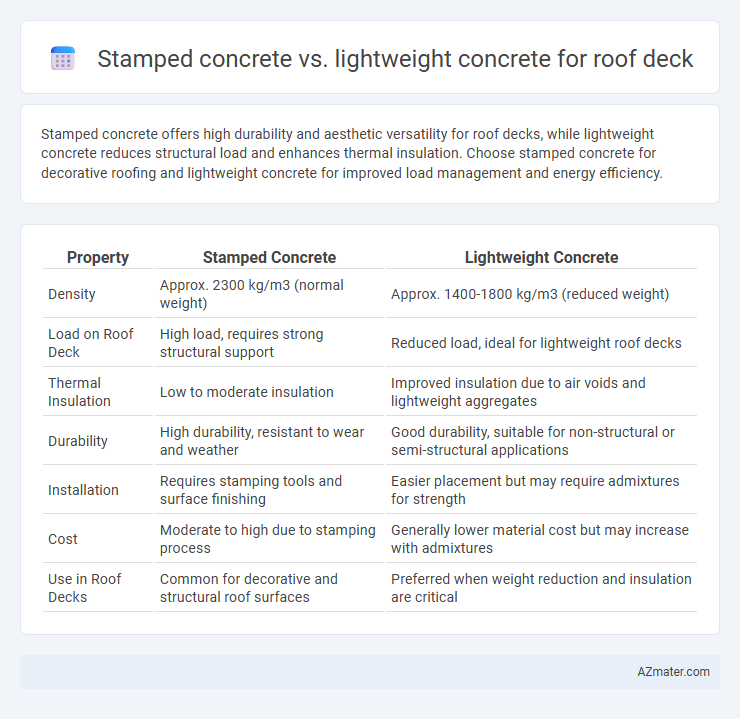Stamped concrete offers high durability and aesthetic versatility for roof decks, while lightweight concrete reduces structural load and enhances thermal insulation. Choose stamped concrete for decorative roofing and lightweight concrete for improved load management and energy efficiency.
Table of Comparison
| Property | Stamped Concrete | Lightweight Concrete |
|---|---|---|
| Density | Approx. 2300 kg/m3 (normal weight) | Approx. 1400-1800 kg/m3 (reduced weight) |
| Load on Roof Deck | High load, requires strong structural support | Reduced load, ideal for lightweight roof decks |
| Thermal Insulation | Low to moderate insulation | Improved insulation due to air voids and lightweight aggregates |
| Durability | High durability, resistant to wear and weather | Good durability, suitable for non-structural or semi-structural applications |
| Installation | Requires stamping tools and surface finishing | Easier placement but may require admixtures for strength |
| Cost | Moderate to high due to stamping process | Generally lower material cost but may increase with admixtures |
| Use in Roof Decks | Common for decorative and structural roof surfaces | Preferred when weight reduction and insulation are critical |
Introduction to Roof Deck Concrete Options
Stamped concrete offers decorative surface patterns and durability suitable for roof decks requiring aesthetic appeal and slip resistance. Lightweight concrete provides reduced load on structural elements, enhanced thermal insulation, and improved fire resistance, making it ideal for roof decks in buildings with strict weight and energy efficiency requirements. Both options balance structural performance and functional benefits based on specific roof deck design priorities.
What is Stamped Concrete?
Stamped concrete is a decorative concrete surface designed to replicate the appearance of natural materials such as stone, brick, or tile, often used for roof decks to enhance aesthetic appeal while maintaining durability. It consists of a concrete slab that is poured, colored, and then textured with molds or stamps before it fully hardens, providing a slip-resistant and weather-resistant surface ideal for outdoor roofing applications. Compared to lightweight concrete, stamped concrete offers superior visual customization and strength but may require more maintenance to prevent cracking and wear over time.
What is Lightweight Concrete?
Lightweight concrete, known for its reduced density compared to traditional concrete, uses lightweight aggregates such as expanded clay, shale, or pumice to improve structural efficiency on roof decks while minimizing load. This type of concrete offers enhanced thermal insulation and lowers the dead load on supporting elements, extending the lifespan of roofing systems. In contrast, stamped concrete emphasizes aesthetic appeal with textured and patterned surfaces but typically carries a higher weight and lacks the insulation benefits of lightweight concrete.
Key Differences Between Stamped and Lightweight Concrete
Stamped concrete offers a highly decorative finish with textured patterns and colors, enhancing aesthetic appeal for roof decks. Lightweight concrete provides superior thermal insulation and reduced structural load, making it ideal for enhancing energy efficiency and structural safety. The primary differences lie in stamped concrete's focus on surface design and lightweight concrete's emphasis on reduced density and insulation performance.
Strength and Durability Comparison
Stamped concrete offers superior compressive strength, typically ranging from 4,000 to 5,000 psi, making it highly durable for roof decks exposed to heavy loads. Lightweight concrete, with strengths often between 1,500 and 4,000 psi, provides enhanced thermal insulation and reduced structural load but generally has lower overall strength compared to stamped concrete. Durability-wise, stamped concrete resists cracking and weathering better under frequent foot traffic and environmental stress, whereas lightweight concrete's durability depends on proper curing and reinforcement to prevent surface wear and potential structural issues.
Aesthetic Appeal and Design Versatility
Stamped concrete offers superior aesthetic appeal and design versatility for roof decks due to its ability to mimic natural materials such as stone, brick, or wood while providing customizable patterns and colors that enhance architectural elements. Lightweight concrete, while advantageous for reducing structural load, typically presents a more uniform and limited visual texture, making it less ideal for intricate design applications. Selecting stamped concrete enables designers to achieve both functional performance and visually striking, unique roof deck surfaces.
Weight and Structural Load Considerations
Stamped concrete typically weighs around 150 pounds per cubic foot, significantly increasing the structural load on roof decks compared to lightweight concrete, which averages between 90 to 115 pounds per cubic foot. The reduced density of lightweight concrete considerably lessens dead load, making it a preferred option for roof decks where weight limitations and structural integrity are critical. Engineers must carefully assess load-bearing capacity and structural support when choosing between stamped and lightweight concrete for roof deck applications.
Installation Process and Cost Factors
Stamped concrete for roof decks requires intricate mold and pattern placement, demanding skilled labor and longer installation time, which increases overall costs. Lightweight concrete offers faster, simpler installation due to its reduced weight and ease of handling, lowering labor expenses and minimizing structural support requirements. Cost factors for stamped concrete mainly stem from customization and finishing, while lightweight concrete's savings come from expedited installation and decreased structural reinforcement needs.
Maintenance and Longevity
Stamped concrete for roof decks offers durable resistance to weathering with relatively low maintenance, requiring periodic sealing to prevent cracking and fading; its lifespan typically exceeds 30 years when properly maintained. Lightweight concrete provides enhanced thermal insulation and reduces structural load but may demand more frequent inspections and repairs due to its increased porosity and vulnerability to moisture infiltration. Choosing between them depends on balancing aesthetic appeal and ease of upkeep against long-term durability in exposed roof environments.
Choosing the Best Concrete Type for Your Roof Deck
Stamped concrete offers superior aesthetics and durability for roof decks, providing a decorative finish with enhanced slip resistance. Lightweight concrete reduces structural load, improving support and insulation while offering adequate strength for roof decking applications. Selecting the best concrete depends on balancing weight limitations, desired appearance, and thermal performance requirements of your roof deck project.

Infographic: Stamped concrete vs Lightweight concrete for Roof deck
 azmater.com
azmater.com